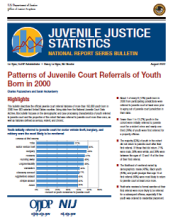Black
Secular Change in Popular Morphological Traits of the Skull and Pelvis
Campus Climate and Sexual Violence Experiences of Students Attending Historically Black Colleges and Universities
Predicting Recidivism with Neural Network Models
National Institute of Justice’s Forecasting Recidivism Challenge: Team “DEAP” (Final Report)
Black Box Evaluation of Bloodstain Pattern Analysis Conclusions
Patterns of Juvenile Court Referrals of Youth Born in 2000
The History and Legacy of the Latent Fingerprint Black Box Study
Testing the Accuracy and Reliability of Palmar Friction Ridge Comparisons: A Black Box Study, Full Report
Booker and Beyond Analyzing Sentencing Reform and Exploring New Research Directions
This webinar features a discussion of previously published research on the U.S. Supreme Court’s 2005 Booker decision - which effectively transformed the United States Sentencing Guidelines from a mandatory, to an advisory, system. The presentation will address selected research findings from the last 15 years. Individual participants will briefly review their previous research findings with particular attention paid to the analytic methods used.
See the YouTube Terms of Service and Google Privacy Policy
"All I remember is the black eye": A distinctive facial feature harms eyewitness identification
Multi-Component Efforts to Improve School Safety - Breakout Session, NIJ Virtual Conference on School Safety
On February 16-18, 2021, the National Institute of Justice hosted the Virtual Conference on School Safety: Bridging Research to Practice to Safeguard Our Schools. This video includes the following presentations:
See the YouTube Terms of Service and Google Privacy Policy
Dual System Youth: At the Intersection of Child Maltreatment and Delinquency
Across the country, child welfare and juvenile justice systems now recognize that youth involved in both systems (i.e., dual system youth) are a vulnerable population who often go unrecognized because of challenges in information-sharing and cross system collaboration. In light of these challenges, national incidence rates of dual system youth are not known.
See the YouTube Terms of Service and Google Privacy Policy







